- West Virginia University Health System leaders are reducing cancer outcome disparities through a mobile lung cancer screening (LCS) program that provides the affordable service to residents in rural areas.
- A team comprising a director, a pulmonologist, radiologists, nurse navigators, a CT technician, a driver, and public health professionals partners with clinics in 150 rural West Virginia communities to catch lung cancer early.
- Since the program’s inception in 2021, the team has screened more than 420 patients.
Their approach is ambitious: Instead of expecting patients to come to them, the team has instituted a mobile LCS unit that travels statewide to screen as many eligible patients as possible regardless of their insurance status. Known as LUCAS, the lung cancer screening program is bringing much-needed care to regions in which geography and socioeconomic factors often limit access.
“We know West Virginia has the highest rate of smoking in the United States and the second-highest rate of lung cancer diagnosed each year,”2 says Hannah W. Hazard-Jenkins, MD, FACS, director of the WVU Cancer Institute (WVUCI) and a breast oncologist. Despite this, and even with updated expert guidance widening eligibility to more people, less than 4% of those eligible for low‐dose CT (LDCT) screening in the state make it to a stationary site.3 “Knowing the needs of our communities and state, we initiated work on our mobile screening program in 2017 to make screening more accessible and save lives. This came to fruition in 2021,” she says.
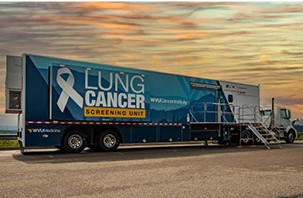 The LUCAS mobile unit is a tractor-trailer equipped with a low-dose CT scanner and an independent power supply that serves communities without ready access to lung cancer screening. |
Laying the Foundation
When the WVUCI started exploring options for a mobile LCS unit in 2017, screening for lung cancer was a relatively new concept. With the expanded guidelines in 2021, nearly twice as many patients are now eligible for lung cancer screening; however, at the time the team was developing the LUCAS program in 2017, USPSTF guidelines around LCS were more stringent and most counties in West Virginia did not have LCS programs. Consequently, at the time, fewer than 2% of eligible patients in the state were being screened.Another headwind facing the group was the perception that people who smoke bring lung cancer on themselves. “Unfortunately, as a society, we have tried to convince people who smoke to stop smoking through scare tactics and shame,” notes Hazard‐Jenkins, who also serves as the Jean & Laurence DeLynn Chair of Oncology at the WVU School of Medicine. “In reality, nicotine is one of the most addictive substances, and it also happens to be legal. Early on, our concern was that patients and/or providers would be less eager to adopt a screening program to address a cancer that was a result of what is viewed as a choice people make.”
Cognizant of the challenges confronting them, Hazard‐Jenkins and her colleagues first reviewed research from the WVU Cancer Prevention and Control (CPC) Program and the Patient Advocate Foundation (PAF), which jointly received funding in 2015 to investigate and address low LCS rates in West Virginia. The partnership with the PAF was centered around promoting LCS guidelines to the general public and developing provider educational opportunities around screening for lung cancer. Community and provider surveys associated with the project demonstrated an overall lack of awareness about lung cancer screening. Dubbed the “West Virginia Lung Cancer Screening Project,” the initiative laid some of the groundwork that helped prepare the state for LUCAS.
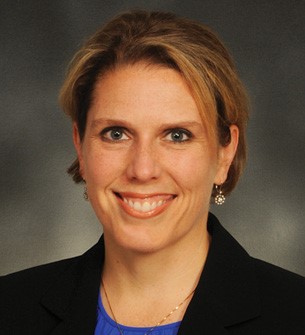 Breast oncologist Hannah W. Hazard-Jenkins, MD, FACS, who serves as director of the WVU Cancer Institute and chair of oncology at the WVU School of Medicine, led the effort to implement the LUCAS mobile unit program. |
Making the Case
Next, to establish evidence of a persistent care gap, Hazard-Jenkins and her team conducted a statewide community needs assessment in 2017. As part of this effort, the CPC reviewed the state’s smoking rates, census data by age, and other measures to calculate the number of people eligible for lung cancer screening. As a result, they estimated that 120,000 West Virginians were eligible for lung cancer screening, pointing to a significant shortfall in the number of established LCS programs. “We looked at where facility‐based lung cancer screening programs were being established, and our research showed that residents in 42 of our state’s 55 counties did not have immediate access to this service,” Hazard-Jenkins says.The team also found that those residents who are eligible for the service generally reside in more rural counties, which are less likely to have free-standing hospitals, and those who do have access to healthcare often receive that care from outpatient clinics or critical access emergency rooms. Hazard-Jenkins explains, “The current U.S. healthcare model is convenient to those who live near hospitals and major healthcare facilities. For those who don’t, however, getting to healthcare in general — and screening in particular — is very difficult.”
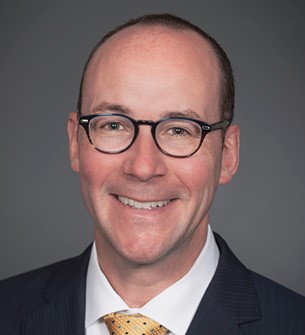 Albert L. Wright, Jr., president and chief executive officer of the WVU Health System, shared Hazard‐Jenkins’ concern over the lack of available lung cancer screening programs in the state and supported development of the LUCAS program. |
Many of Hazard‐Jenkins’ colleagues shared her concern over the lack of available LCS programs, including Albert L. Wright, Jr., president and chief executive officer of the WVU Health System. “We live and work in a state with a lot of healthcare challenges, and cancer is one of the biggest,” Wright observes. “If we’re going to effectively detect cancers early, we must be sure we’re providing a mechanism to do that.”
Based on the strength of the needs assessment, which was sponsored by the West Virginia Department of Health and Human Resources, the WVU Cancer Institute’s CPC sought input from WVU Health System leaders to assemble a team of experts to bring the mobile LCS program into existence.
Building on Past Success
Instead of conceptualizing a mobile LCS program from scratch, the team decided to iterate on an already‐existing mobile screening program called Bonnie’s Bus.4 A collaboration of the WVU Medicine system and the CPC, Bonnie’s Bus rolled into the field in 2009, delivering mobile breast cancer screening across West Virginia. In the years since, the mobile mammography unit has traveled over 199,000 miles, providing more than 25,000 screening mammograms and detecting more than 125 cases of breast cancer. Building on this expertise, Hazard-Jenkins and her colleagues developed a mobile LCS unit to reach patients in rural areas of the state.As a first step, the WVUCI assembled a team that included its director, a radiologist, mobile team experts, the CPC director, and financial experts who prepared a business plan to demonstrate the existing need to health system leadership. “With the alarming statistics of lung cancer incidence and mortality in our state, there was no denying an innovative approach to adoption of this life-saving screening modality was essential,” says Hazard‐Jenkins. “That said, it was important to gauge the interest of our community partners — the providers who would identify and schedule eligible patients — before engaging senior-level administrators. We were fortunate that everyone we approached was eager to support this project.”
One of the later additions to the LUCAS program’s leadership team was Kyle Chapman, MD, assistant professor of pulmonary and critical care medicine at WVU. “When I joined West Virginia University as a faculty member in 2019, the LUCAS mobile lung cancer screening unit was already in development, at least conceptually,” says Chapman, who at the time was serving as the lead pulmonologist for the existing lung cancer screening program.
“Before my involvement with the LUCAS program, to promote lung cancer screening, I developed a quality improvement project looking at barriers to screening in primary care. Among other issues, transportation and distance to CT scanners were commonly identified as barriers. As a mobile platform, LUCAS uniquely solves those challenges.”
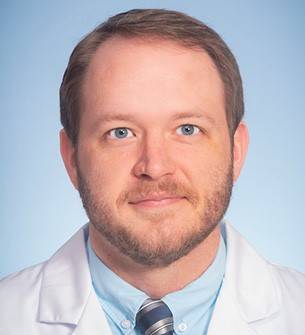 Of the two cases of cancer detected thus far by the LUCAS program, Kyle Chapman, MD, assistant professor of pulmonary and critical care medicine at WVU notes that the affected patients would likely not have been diagnosed until much later in their disease course had it not been for the mobile program. |
Procuring Funds
Once Hazard‐Jenkins and her colleagues successfully aligned health system and physician stakeholders, the next step involved securing financing. “We wanted to stand up the program to be as financially independent as possible,” notes Hazard‐Jenkins. “So we had to secure donor support.” To that end, the WVUCI’s philanthropy office sought individual donors and established relationships with foundations in the local community. In addition, to help defray costs, the team secured a corporate partnership from a company that had a developing interest in the mobile screening space.To get the unit on the road, Hazard-Jenkins says that the team raised about $2.3 million. “We had donors at all levels, be it small amounts to commitments of $500,000,” she states. “The constant among all donors was a desire to elevate the health and wellness of the state.” In addition to the donors, the corporate partner committed to providing funds to help cover the operational expenses involved in the lead-up to deployment of the truck.
One of the most critical costs that team leaders knew the funding needed to cover was the imaging‐related expenses of those who are either uninsured or underinsured. For eligible patients with Medicare, Medicaid, or private insurance, most costs related to the scan would be covered, but for those lacking insurance, alternative funding would be necessary. “We knew we needed to secure enough money, either through grants or donations, to cover under-insured West Virginia residents who meet screening guidelines,” Hazard‐Jenkins says. “For our mobile program, we had to ensure that no screening-eligible West Virginia resident is ever turned away.”
Opening accessibility in this way proved attractive to community clinics, several of which would ultimately work closely with the CPC to schedule LUCAS visits. “We have a patient population that is largely impoverished, under income, underinsured, uninsured, and rurally secluded with transportation difficulties,” explains Kayetlyn Edinger, manager of operations at Monongahela Valley Association of Health Centers (MVA), a Federally Qualified Health Center (FQHC) located in Fairmont, West Virginia. “Bringing low‐dose CT technology closer to home for these patients can make all the difference in the world. And the possibility of paying for uninsured residents to receive screening without fear of cost was ideal.”
Assembling the Unit
With funds now in place, the team undertook a search for the vendor best suited to build out the mobile unit. “Finding the right vendor that understands the intricacies of a mobile program and the terrain you will be traveling is a significant challenge,” Hazard‐Jenkins says. “With a large build like a mobile unit, you need to add in some time for things to get delayed. LUCAS was built during COVID, so many components were delayed due to circumstances beyond our control.”Because it would need to haul equipment of considerable size and weight, the team decided to purchase a tractor-trailer to convey the mobile LCS unit across the state. In their formulation, the trailer would house the CT unit, while the tractor truck would haul the trailer. Once the team chose a vendor and bought the vehicle, work commenced on the truck.
In addition to covering operational expenses and the cost of providing care to the uninsured, raising money to equip the truck with its own power supply became another major goal. “We go into the smallest of clinics through the windy roads of West Virginia,” Hazard-Jenkins explains. “When we realized that most of the community partner sites would not have sufficient power, we had to build a generator sufficient to power the mobile unit in these more remote locations.” To pull the generator, Hazard-Jenkins and her colleagues purchased a pickup truck.
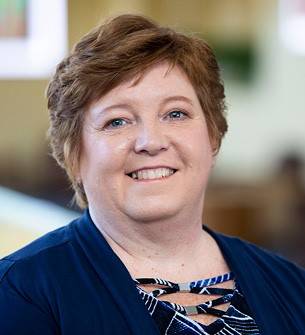 Stephenie Kennedy‐Rea, EdD, WVU Cancer Institute associate director and director of the WVU Cancer Prevention and Control Program, notes that in addition to providing state-of-the-art care, the WVUCI is also a research institution that explores the use of cutting-edge technology, including artificial intelligence. |
Organizing the Workflow
As construction began on the mobile LCS unit, LUCAS program leaders turned to designing a workflow that would ensure timely delivery of imaging results to the ordering physician. Program facilitators followed the same playbook that was used to establish Bonnie’s Bus: The WVUCI Mobile Cancer Screening Program would partner with more than 150 community clinics, health systems, small and large businesses, Federally Qualified Health Clinics, and other entities throughout the state to offer the service.To facilitate patient flow, clinics would identify eligible LCS candidates and order the imaging. Once scans were run, radiologists located in Morgantown would read the images and the results would then be conveyed back to the ordering provider with the option of doing further work-up in either Morgantown or at a facility closer to the patient’s home. “If a patient needs something other than continued scans in a year, we encourage our partners to refer them to their local pulmonologist or thoracic surgeon,” notes Chapman. “If none are available in a timely manner, we offer to evaluate them at our main campus.”
As with the mobile mammography program, LUCAS team leaders planned for a navigator to work with the ordering provider to follow up on abnormal imaging, when necessary. In addition, the team agreed to monitor those patients requiring follow‐up imaging for as long as medically necessary. To promote the service among potential imaging candidates, WVUCI staff in partnership with WVU Medicine marketing staff created patient-oriented marketing materials. In addition, the mobile unit team develops and shares all program information on social media, including a tailored flyer for local promotions. (See the program’s Facebook page for details: https://bit.ly/WVULUCAS .) WVU Medicine marketing staff also helps promote specific visits by sending press releases to local media prior to screening dates.
To bring the program one step closer to reality, Hazard‐Jenkins and her team decided to create a detailed list of what was needed for the LUCAS program to run at optimal levels. To this end, they sought input from every relevant department to review the plans and talk through scenarios the mobile team might encounter. To ensure maximum compliance, the team designed the interior of the LUCAS unit to be as inviting and non-threatening as possible.
Benefiting from their experience with Bonnie’s Bus, program leaders knew they’d only need to recruit a couple of staff members to run the field operation: the person driving the mobile unit would perform the intake of patients, which would involve explaining the process and answering any questions, while a CT technologist would perform the scan and calm any potential fears patients may have. The CT technologist would also be certified to discuss tobacco cessation strategies with those patients interested in quitting smoking.
Rolling into the Field
With these plans in place, the LUCAS program began with a soft launch, screening 168 patients at 26 sites during September through December 2021. For the remainder of 2022, the team has 96 site visits scheduled as of this writing. “One challenge with any LCS program is that you will inevitably find many things, the majority of which are not lung cancer,” Chapman notes. “We have had 18% of patients with some type of pulmonary abnormality — whether that be nodules, inflammation, or scarring — with varying risks of malignant potential. The majority were recommended for additional imaging at a sooner interval, such as three or six months rather than a year. This percentage was higher than our initial projections.” Aside from these findings, two cases of cancer have been detected so far. “These patients would likely not have been diagnosed until much later in their disease course as they were asymptomatic at the time of screening,” explains Chapman.Constructing a convenient care pathway has been key to the program’s effectiveness. To this end, staff work to coordinate follow‐up care with hospitals throughout the state, many of which are part of WVU Medicine. On those occasions when the most appropriate specialist is not available near a patient’s home, patients visit a primary campus in Morgantown. “As the data matures,” observes Hazard‐Jenkins, “we might be better able to target those areas not just with increased screening, but augmented prevention education and interventions.”
Expanding on Success
Although still in its early days, and despite the fact that ongoing donations are currently required to maintain the program, Hazard‐Jenkins and her team anticipate that in time, the program will cover its costs and, potentially, bring in revenue. In putting together the business plan for the project, Hazard‐Jenkins and her colleagues projected that the downstream revenue from the anticipated positive findings would lead to the program breaking even by year three or four of service. Given this optimistic forecast, the LUCAS team has set a goal of one day delivering LCS in all 55 West Virginia counties.Hazard‐Jenkins notes that updated USPSTF screening guidelines, which now recommend LCS to start at age 50 for those with a minimum of 20 pack-years, will facilitate program expansion by enlarging the population eligible for screening.5 She hopes this will translate into more lives saved and add to the perception that the LUCAS unit can help underserved communities.
“Downstream revenue from lung cancer screening extends beyond lung-specific findings, which could be significant on their own,” says Hazard‐Jenkins. “But beyond becoming financially viable, it was important to us that the unit serve as a tangible, highly visible investment in community health wherever it travels.”
Edinger says that no matter what the future holds, her patients appreciate the LUCAS program in the here‐and‐now. “Our patients, particularly our older patients who ride the bus to our local FQHC facility, have been so grateful for the opportunity for the scan — good results or bad,” concludes Edinger. “Getting scanned for lung cancer was not an option that they had before. For them, getting scanned removes the uncertainty of whether or not they need treatment, and that’s been so encouraging to see.”
End Notes
1. West Virginia Cancer Burden Report, 2019, accessed May 31, 2022, via https://oeps.wv.gov/cancer
/documents/data/burdenreport2019.pdf
2. West Virginia Department of Health & Human Division of Tobacco Prevention Resources Online Resources,
accessed May 31, 2022, via https://dhhr.wv.gov/wvdtp/cessation/Pages/default.aspx#:~:text=West%20Virginia%20continues%
20to%20have,%25%20(BRFSS%2C%202018)
3. American Lung Association State of Cancer 2021, accessed May 31, 2022,via https://www.lung.org/research/
state-of-lung-cancer/states/west-virginia#:~:text=In%20West%20Virginia%2C%204%25%20of,in%20the%20below%20average%20tier.
4. WVU Cancer Institute, Bonnie’s Bus, accessed May 31, 2022, via https://cancer.wvumedicine.org/about-us/
programs/mobile-cancer-screening-program/bonnies-bus/
5. U.S. Preventative Services Task Force, Final Recommendation Statement, Lung Cancer:
Screening, accessed May 31, 2022, via https://www.uspreventiveservicestaskforce.org/uspstf/recommendation/lung-cancer-screening#:~:text=Recommendation%20Summary&text=The%20USPSTF%20recommends%20annual
%20screening,within%20the%20past%2015%20years.
Creative Commons
Screening in Underserved Communities by American College of Radiology is licensed under a Creative Commons Attribution-NonCommercial-NoDerivatives 4.0 International License. Based on a work at www.acr.org/imaging 3. Permissions beyond the scope of this license may be available at www.acr.org/Legal.
Share Your Story
Have a case study idea you’d like to share with the radiology community? To submit your idea please click here.
Now It's Your Turn
Follow these steps to establish a mobile lung cancer screening unit to reach underserved populations in your state, and tell us how you did at imaging3@acr.org or on Twitter with the hashtag #Imaging3:
- Review state‐level data surrounding lung cancer to assess current lung cancer screening practices and smoking rates and gauge the need for a mobile LCS program in your community.
- Explore funding opportunities so that uninsured and underinsured LCS candidates are never turned away from this potentially life‐saving technology.
- Engage community partners to encourage their patients to take advantage of this life-saving care once you make it available in your community. Work with nurse navigators to guide LCS patients through next steps to ensure there are no missed care opportunities.
Author
Chris Hobson, Principal Content Specialist
Join the Discussion

#Imaging3 on Twitter
Call for Case Studies
